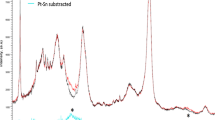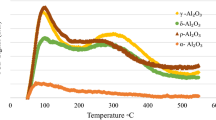Abstract
Eliminating hydrogen from CO via preferential oxidation is an important process in Coal to Ethylene Glycol technology for achieving target products with high yield. During the reaction, applied Pd–Cl/alumina catalyst inevitably experienced structural reconstruction stem from reaction conditions. The deactivation behavior of catalyst was clarified via spectroscopic and microscopic observations. It proposed that surface evolutions about metal sintering should be primarily responsible for the degradation of catalytic efficiency. Owing to chlorine effusion, dependent ferrous contamination and Pd aggregation was emerged on catalyst during the operation. The detachment of coordinative chlorine from active sites in the form of hydrogen chloride favored the accessing of adsorbate on Pd sites which further accelerated the coalescence of clusters. Despite the textural perturbation about porosity and surface area was negligible, on the other hand, the elimination of surface hydroxyls may contribute much for surface passivation and undermined Pd–Cl-Al interfacial interactions.
Graphical Abstract
Diagram illustrated the surface evolutions of catalyst during the operation in hydrogen preferential oxidation.






Similar content being viewed by others
References
Zhang HL, Pan J, Zhou QT, Xia F (2021) Nanometal thermocatalysts: transformations, deactivation, and mitigation. Small 17(7):2005771
Behafarid F, Roldan Cuenya B (2013) Towards the understanding of sintering phenomena at the nanoscale: geometric and environmental effects. Top Catal 56(15–17):1542
Bai YX, Zhang JF, Yang GH, Zhang QD, Pan JX, Xie HJ, Liu XC, Han YZ, Tan YS (2018) Insight into the nanoparticle growth in supported Ni catalysts during the early stage of co hydrogenation reaction: the important role of adsorbed CO molecules. ACS Catal 8(7):6367
Murzin DY (2014) Catalyst deactivation and structure sensitivity. Catal Sci Technol 4(9):3340
Moulijn JA, van Diepen AE, Kapteijn F (2001) Catalyst deactivation: is it predictable? What to do? Appl Catal A 212(1–2):3
Shen Y, Guo Y, Wang L, Wang Y, Guo Y, Gong X, Lu G (2011) The stability and deactivation of Pd–Cu–Clx/Al2O3 catalyst for low temperature CO oxidation: an effect of moisture. Catal Sci Technol 1(7):1202
Zhang S, Cargnello M, Cai W, Murray CB, Graham GW, Pan X (2016) Revealing particle growth mechanisms by combining high-surface-area catalysts made with monodisperse particles and electron microscopy conducted at atmospheric pressure. J Catal 337:240
Hejral U, Muller P, Balmes O, Pontoni D, Stierle A (2016) Tracking the shape-dependent sintering of platinum-rhodium model catalysts under operando conditions. Nat Commun 7:10964
Monai M, Montini T, Melchionna M, Duchon T, Kus P, Tsud N, Prince KC, Matolin V, Gorte RJ, Fornasiero P (2016) Phosphorus poisoning during wet oxidation of methane over Pd@CeO2/graphite model catalysts. Appl Catal B 197:271
Yang Z, Li H, Zhou H, Wang L, Wang L, Zhu Q, Xiao J, Meng X, Chen J, Xiao FS (2020) Coking-resistant iron catalyst in ethane dehydrogenation achieved through siliceous zeolite modulation. J Am Chem Soc 142(38):16429
Somorjai GA, Vanhove MA (1989) Adsorbate-induced restructuring of surfaces. Prog Surf Sci 30(3–4):201
Campbell CT (1997) Ultrathin metal films and particles on oxide surfaces: structural, electronic and chemisorptive properties. Sur Sci Rep 27:1
Hansen TW, Delariva AT, Challa SR, Datye AK (2013) Sintering of catalytic nanoparticles: particle migration or Ostwald Ripening? Acc Chem Res 46(8):1720
Sun JM, Ma D, Zhang H, Liu XM, Han XW, Bao XH, Weinberg G, Pfander N, Su DS (2006) Toward monodispersed silver nanoparticles with unusual thermal stability. J Am Chem Soc 128(49):15756
Bartholomew CH (2001) Mechanisms of catalyst deactivation. Appl Catal A 212(1–2):17
Liu L, Corma A (2018) Metal catalysts for heterogeneous catalysis: from single atoms to nanoclusters and nanoparticles. Chem Rev 118(10):4981
Zhou W, Cheng K, Kang J, Zhou C, Subramanian V, Zhang Q, Wang Y (2019) New horizon in C1 chemistry: breaking the selectivity limitation in transformation of syngas and hydrogenation of CO2 into hydrocarbon chemicals and fuels. Chem Soc Rev 48(12):3193
Cui X, Huang R, Deng D (2021) Catalytic conversion of C1 molecules under mild conditions. EnergyChem 3(1):100050
Yue HR, Zhao YJ, Ma XB, Gong JL (2012) Ethylene glycol: properties, synthesis, and applications. Chem Soc Rev 41(11):4218
Wang C, Han L, Chen P, Zhao G, Liu Y, Lu Y (2016) High-performance, low Pd-loading microfibrous-structured Al-fiber@ns-AlOOH@Pd catalyst for CO coupling to dimethyl oxalate. J Catal 337:145
Xu ZN, Sun J, Lin CS, Jiang XM, Chen QS, Peng SY, Wang MS, Guo GC (2013) High-performance and long-lived Pd nanocatalyst directed by shape effect for CO oxidative coupling to dimethyl oxalate. ACS Catal 3(2):118
Qiao L, Li Q, Zhou Z, Si R, Yao Y (2016) Inert can be advantageous: advisable reconstruction and application of palladium chloride for the preferential oxidation of the hydrogen impurity in carbon monoxide streams. ChemCatChem 8(11):1909
Qiao BT, Lin J, Li L, Wang AQ, Liu JY, Zhang T (2014) Highly active small palladium clusters supported on ferric hydroxide for carbon monoxide-tolerant hydrogen oxidation. ChemCatChem 6(2):547
Conrad H, Ertl G, Latta EE (1974) Coadsorption of hydrogen and carbon-monoxide on a Pd (110) surface. J Catal 35(3):363
Morkel M, Gn R, Freund H-J (2003) Ultrahigh vacuum and high-pressure coadsorption of CO and H2 on Pd(111): a combined SFG, TDS, and LEED study. J Chem Phys 119(20):10853
Jones MG, Nevell TG (1990) Oxidation of hydrogen over supported palladium. J Catal 122(2):219
Avgouropoulos G, Ioannides T (2005) CO tolerance of Pt and Rh catalysts: effect of CO in the gas-phase oxidation of H2 over Pt and Rh supported catalysts. Appl Catal B 56(1–2):77
Oh HS, Yang JH, Costello CK, Wang YM, Bare SR, Kung HH, Kung MC (2002) Selective catalytic oxidation of CO: effect of chloride on supported Au catalysts. J Catal 210(2):375
Iyagba ET, Hoost TE, Nwalor JU, Goodwin JG (1990) The effect of chlorine modification of silica-supported Ru on its CO hydrogenation properties. J Catal 123(1):1
Peterson EJ, Delariva AT, Lin S, Johnson RS, Guo H, Miller JT, Kwak JH, Peden CHF, Kiefer B, Allard LF, Ribeiro FH, Datye AK (2014) Low-temperature carbon monoxide oxidation catalysed by regenerable atomically dispersed palladium on alumina. Nat Commun 5:4885
Baraj E, Ciahotny K, Hlincik T (2021) The water gas shift reaction: catalysts and reaction mechanism. Fuel 288:119817
Cargnello M, Doan-Nguyen VV, Gordon TR, Diaz RE, Stach EA, Gorte RJ, Fornasiero P, Murray CB (2013) Control of metal nanocrystal size reveals metal-support interface role for ceria catalysts. Science 341(6147):771
Lin W, Zhu YX, Wu NZ, Xie YC, Murwani I, Kemnitz E (2004) Total oxidation of methane at low temperature over Pd/TiO2/Al2O3: effects of the support and residual chlorine ions. Appl Catal B 50(1):59
Reguer S, Kergourlay F, Foy E, Neff D, Vantelon D, Cotte M, Mirambet F, Dillmann P (2020) XANES at the Cl K-edge as a relevant technique to reveal the iron archaeological artefact dechlorination treatments. J Anal At Spectrom 35(10):2358
Zhan C, Wang Q, Zhou L, Han X, Wanyan Y, Chen J, Zheng Y, Wang Y, Fu G, Xie Z, Tian ZQ (2020) Critical roles of doping Cl on Cu2O nanocrystals for direct epoxidation of propylene by molecular oxygen. J Am Chem Soc 142(33):14134
Paredes-Nunez A, Lorito D, Schuurman Y, Guilhaume N, Meunier FC (2015) Origins of the poisoning effect of chlorine on the CO hydrogenation activity of alumina-supported cobalt monitored by operando FT-IR spectroscopy. J Catal 329:229
Schubert MM, Venugopal A, Kahlich MJ, Plzak V, Behm RJ (2004) Influence of H2O and CO2 on the selective CO oxidation in H2-rich gases over Au/alpha-Fe2O3. J Catal 222(1):32
Toso A, Colussi S, Padigapaty S, de Leitenburg C, Trovarelli A (2018) High stability and activity of solution combustion synthesized Pd-based catalysts for methane combustion in presence of water. Appl Catal B 230:237
Date M, Okumura M, Tsubota S, Haruta M (2004) Vital role of moisture in the catalytic activity of supported gold nanoparticles. Angew Chem Int Edit 43(16):2129
Kim KD, Nam IS, Chung JS, Lee JS, Ryu SG, Yang YS (1994) Supported PdCl2-CuCl2 catalysts for carbon-monoxide oxidation 1 effects of catalyst composition and reaction conditions. Appl Catal B 5(1–2):103
Liu L, Corma A (2020) Evolution of isolated atoms and clusters in catalysis. Trends Chem 2(4):383
Ouyang RH, Liu JX, Li WX (2013) Atomistic theory of ostwald ripening and disintegration of supported metal particles under reaction conditions. J Am Chem Soc 135(5):1760
Johnston P, Joyner RW (1993) Influence of chlorine on the lability of small rhodium particles in carbon monoxide. J Chem Soc Faraday Trans 89(5):863
Kondarides DI, Verykios XE (1998) Effect of chlorine on the chemisorptive properties of Rh/CeO2 catalysts studied by XPS and temperature programmed desorption techniques. J Catal 174(1):52
Ouyang L, Tian PF, Da GJ, Xu XC, Ao C, Chen TY, Si R, Xu J, Han YF (2015) The origin of active sites for direct synthesis of H2O2 on Pd/TiO2 catalysts: interfaces of Pd and PdO domains. J Catal 321:70
Karhu H, Kalantar A, Väyrynen IJ, Salmi T, Murzin DY (2003) XPS analysis of chlorine residues in supported Pt and Pd catalysts with low metal loading. Appl Catal A 247(2):283
Parkinson GS, Novotny Z, Argentero G, Schmid M, Pavelec J, Kosak R, Blaha P, Diebold U (2013) Carbon monoxide-induced adatom sintering in a Pd-Fe3O4 model catalyst. Nat Mater 12(8):724
Simonsen SB, Chorkendorff I, Dahl S, Skoglundh M, Sehested J, Helveg S (2010) Direct observations of oxygen-induced platinum nanoparticle ripening studied by in situ TEM. J Am Chem Soc 132(23):7968
Newton MA, Belver-Coldeira C, Martinez-Arias A, Fernandez-Garcia M (2007) Dynamic in situ observation of rapid size and shape change of supported Pd nanoparticles during CO/NO cycling. Nat Mater 6(7):528
Valero MC, Raybaud P, Sautet P (2006) Influence of the hydroxylation of gamma-Al2O3 surfaces on the stability and diffusion of single Pd atoms: a DFT study. J Phys Chem B 110(4):1759
Addou R, Senftle TP, O’Connor N, Janik MJ, van Duin ACT, Batzill M (2014) Influence of hydroxyls on Pd atom mobility and clustering on rutile TiO2(011)-2x1. ACS Nano 8(6):6321
Gravil PA, Toulhoat H (1999) Ethylene, sulphur, and chlorine coadsorption on Pd(111): a theoretical study of poisoning and promotion. Surf Sci 430(1–3):192
Kogler M, Kock EM, Klotzer B, Schachinger T, Wallisch W, Henn R, Huck CW, Hejny C, Penner S (2016) High-temperature carbon deposition on oxide surfaces by CO disproportionation. J Phys Chem C 120(3):1795
Biesinger MC, Payne BP, Grosvenor AP, Lau LWM, Gerson AR, Smart RS (2011) Resolving surface chemical states in XPS analysis of first row transition metals, oxides and hydroxides: Cr, Mn, Fe, Co, and Ni. Appl Surf Sci 257(7):2717
Lin J, Qiao BT, Li L, Guan HL, Ruan CY, Wang AQ, Zhang WS, Wang XD, Zhang T (2014) Remarkable effects of hydroxyl species on low-temperature CO (preferential) oxidation over Ir/Fe(OH)x catalyst. J Catal 319:142
Acknowledgements
This work was supported by National Key R&D Program of China (2017YFB0307301, 2017YFA0206802, 2018YFA0704502), the Strategic Priority Research Program of the Chinese Academy of Sciences (XDA21020800), the Science and Technology Service Network Initiative (KFJ-STSQYZD-048), the NSF of China (21703247), the Science Foundation of Fujian Province (2018J05029, 2019J05156, 2019H0053) and Guizhou Province ([2018]2193, 2020-1-10). This work was also supported by the BL14W1 beam line of Shanghai Synchrotron Radiation Facility.
Author information
Authors and Affiliations
Corresponding author
Ethics declarations
Conflict of interest
We declare that the authors have no conflict of interest.
Additional information
Publisher's Note
Springer Nature remains neutral with regard to jurisdictional claims in published maps and institutional affiliations.
Supplementary Information
Below is the link to the electronic supplementary material.
Rights and permissions
About this article
Cite this article
Qiao, L., Zhou, Z., Zeng, Y. et al. Evolution of Surface Structure on Pd–Cl/Alumina Catalyst During CO Purification Process. Catal Lett 153, 493–502 (2023). https://doi.org/10.1007/s10562-022-03981-w
Received:
Accepted:
Published:
Issue Date:
DOI: https://doi.org/10.1007/s10562-022-03981-w




